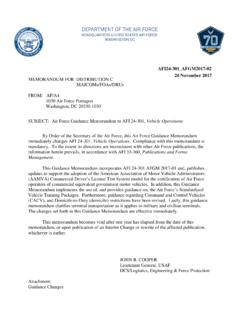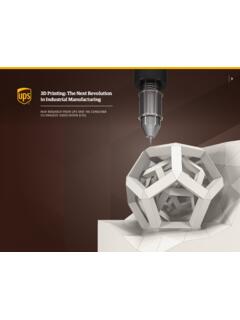Transcription of Reliability-Centered Maintenance (RCM) Handbook
1 Downloaded from S9081-AB-GIB-010. REVISION 1. Reliability-Centered Maintenance (RCM). Handbook This manual supersedes S9081-AB-GIB-010, dated October 1983, which shall be destroyed. DISTRIBUTION STATEMENT A: APPROVED FOR PUBLIC RELEASE. DISTRIBUTION IS UNLIMITED. PUBLISHED BY DIRECTION OF COMMANDER, NAVAL SEA SYSTEMS COMMAND. 0910-LP-106-0318 18 April 2007. Downloaded from Downloaded from Downloaded from Downloaded from S9081-AB-GIB-010. FORWARD. If you require assistance, contact distance support (anchor desk) via the web ) and via the toll free number (1-877-4-1-TOUCH [86824]). Ships, training activities, supply points, depots, Naval Shipyards and Supervisors of Shipbuilding are requested to arrange for the maximum practical use and evaluation of NAVSEA technical manuals. All errors, omissions, discrepancies, and suggestions for improvement to NAVSEA.
2 Technical manuals shall be forwarded to: COMMANDER. CODE 310 TMDER, BLDG 1388. NAVSURFWARCENDIV NSDSA. 4363 MISSILE WAY. PORT HUENEME CA 93043-4307. on NAVSEA Technical manual Deficiency/Evaluation Report, form NAVSEA. 4160/1. All feedback comments shall be thoroughly investigated and originators will be advised of action resulting there from. Three copies of NAVSEA 4160/1 are included at the end of each separately bound technical manual 8-1/2 x 11 inches or larger. Copies of form NAVSEA 4160/1 may be downloaded from: Users are encouraged to transmit deficiency submittals via the Naval Systems Data Support Activity Web page located at: Urgent priority TM deficiencies shall be reported by Naval message to Port Hueneme Division, Naval Surface Warfare Center (Code 311), Port Hueneme, CA. Local message handling procedures shall be used.
3 The message shall identify each TM deficiency by TM identification number and title. iii Downloaded from S9081-AB-GIB-010. THIS PAGE INTENTIONALLY LEFT BLANK . iv Downloaded from S9081-AB-GIB-010. Reliability-Centered Maintenance (RCM) Handbook Contents Section Title Page 1 Introduction to RCM 1-1. Purpose 1-1. History of RCM 1-1. Basis for RCM 1-3. RCM Certification 1-4. Summary 1-5. 2 Fundamentals of Maintenance 2-1. Engineering (ME). Failures Happen 2-1. Not All Failures Have the Same 2-2. Probability Not All Failures have the Same 2-4. Consequences Simple Components Wear-Out, Complex 2-8. Systems Break Down Good Maintenance provides required 2-8. functionality for lowest practicable cost Maintenance Can Only Achieve Inherent 2-9. Design reliability Hidden Functions Require Special 2-9. Treatment v Downloaded from S9081-AB-GIB-010.
4 Reliability-Centered Maintenance (RCM) Handbook Contents Section Title Page Unnecessary Maintenance Takes 2-10. Resources Away From Necessary Maintenance Good Maintenance Programs Undergo 2-11. Continuous Improvement Summary 2-13. 3 What Comprises Maintenance ? 3-1. Definition of Maintenance 3-1. Three Categories of Maintenance 3-2. Five Types of Preventive Maintenance 3-4. Tasks Summary 3-10. 4 The Rules of RCM 4-1. Three Hypotheses 4-1. All Maintenance Tasks Must Be 4-3. Applicable (Relevant). All Maintenance Tasks Must Be Effective 4-4. (Have Value). Why We Need RCM Methodology 4-5. Summary 4-5. 5 Two RCM Processes 5-1. Summary 5-3. vi Downloaded from S9081-AB-GIB-010. Reliability-Centered Maintenance (RCM) Handbook Contents Section Title Page 6 The Classic RCM Process 6-1. Analyst Selection and Training 6-1.
5 Information Collection 6-2. System Partitioning and Identification 6-2. Systems Analysis 6-3. The RCM Methodology 6-3. Designing an RCM-Based Preventive 6-4. Maintenance Program (MIL-P-24534A). Phase 1: Functional Block Diagram and 6-5. the Master Systems and Subsystems Index (OPNAV Form 4790/114). Phase 2: Functional Failure Analysis 6-7. (OPNAV Form 4790/116). Phase 3: Additional Functionally 6-8. Significant Item Selection (OPNAV Form 4790/117). Phase 3 Continued: Functionally 6-9. Significant Items Index (OPNAV Form 4790/118). Phase 4: Failure Modes and Effects 6-9. Analysis (OPNAV Form 4790/119). Phase 5: Decision Logic Tree Analysis 6-10. (OPNAV Form 4790/120). Phase 6: Servicing and Lubrication 6-16. Analysis (OPNAV Form 4790/121). vii Downloaded from S9081-AB-GIB-010. Reliability-Centered Maintenance (RCM) Handbook Contents Section Title Page Periodicity Considerations 6-16.
6 Phase 7: Audit and Preparation of the 6-16. Maintenance Requirement: Maintenance Requirement Index (MR) (OPNAV Form 4790/123). Phase 8: Method Study and Procedure 6-16. Evaluation for the New Tasks and Revised Maintenance Requirement Cards (MRCs). (OPNAV Form 4790/130). Phase 9: Maintenance Requirement Task 6-17. Definition (OPNAV Form 4790/124). Phase 10: Inactive Equipment 6-17. Maintenance (OPNAV Form 4790/129). Phase 11: Unscheduled Maintenance 6-18. Phase 12: MRC/MIP Preparation 6-18. (OPNAV Forms 4790/82, 83, 84, and 85). eRCM 6-18. Summary 6-19. 7 The Backfit Process 7-1. Analyst Selection and Training 7-1. Information Collection 7-1. The Backfit RCM Methodology 7-2. viii Downloaded from S9081-AB-GIB-010. Reliability-Centered Maintenance (RCM) Handbook Contents Section Title Page Conducting a Backfit RCM Analysis of an 7-2.
7 Existing PMS Program Finalizing PMS Task Revisions 7-7. Summary 7-8. Appendix A Glossary A-1. Appendix B MIL-P-24534A (NAVY) Data Forms B-1. Appendix C NAVSEA/SPAWAR Technical manual C-1. Deficiency/Evaluation Report (TMDER). ix Downloaded from S9081-AB-GIB-010. THIS PAGE INTENTIONALLY LEFT BLANK . x Downloaded from S9081-AB-GIB-010. Section 1 Introduction to RCM. Purpose This Handbook provides Navy Maintenance practitioners a reference document for applying the principles of Reliability-Centered Maintenance (RCM) to the evaluation of both new and well- established ship planned Maintenance system (PMS) preventive Maintenance requirements. It is intended as a supplement to the Naval Sea Systems Command Reliability-Centered Maintenance -based certification program for those who develop, modify, review and authorize Planned Maintenance System tasks for Navy ships, systems, and equipment.
8 The Handbook introduces basic principles of Maintenance and illustrates how these principles establish rules for good Maintenance tasks. It describes how these rules are used to develop Maintenance requirements and associated documentation for new systems and equipment as well as to evaluate and improve the quality and effectiveness of well-established Maintenance programs. Requirements for analysis of preventive Maintenance requirements and for development of associated support documentation are defined in MIL-P-24534A, Planned Maintenance System: development of Maintenance Requirement Cards, Maintenance Index Pages, and Associated Documentation.. History of RCM. Logical methods for designing preventive Maintenance programs started about a half century ago. This brief history sets the stage for detailed discussion of the Reliability-Centered Maintenance methodology mandated by the Chief of Naval Operations for ship Maintenance .
9 OPNAVINST (series). Maintenance Policy for Navy Ships, and OPNAVINST (series) Ships' Maintenance and Material management (3-M) System Policy require the use of RCM for the development of Maintenance programs and associated Maintenance tasks. Efforts to look deeply into the effectiveness of preventive Maintenance as a process for avoiding failure began in the late 1950s. Those involved in establishing preventive Maintenance requirements before then may have been so convinced of the value of their actions that they saw no need to prove its truth. They reacted almost entirely to each event as it occurred rather than to generalize their experience. The introduction of jet aircraft fleets led the airline industry to apply a growing expertise in the process of analysis to improving the effectiveness of preventive Maintenance for transport aircraft.
10 Since the underlying reason for preventive Maintenance is the belief that reliability of hardware decreases with use, the first efforts examined the relationship between reliability and age (use). This was done by application of techniques already used by life insurance actuaries. In 1967, the airline industry's Maintenance Steering Group (MSG) first applied decision tree logic a series of questions that lead to a supportable Maintenance task decision to the problem of identifying required preventive Maintenance tasks. This predecessor of RCM proved an efficient approach, since it focused directly on the impact of unreliability on operations and safety. The following year, decision tree logic formed the basis for design of the initial Boeing 747 Maintenance program. In the ensuing 1-1. Downloaded from S9081-AB-GIB-010.






